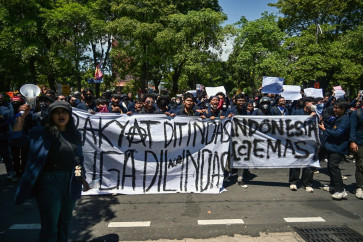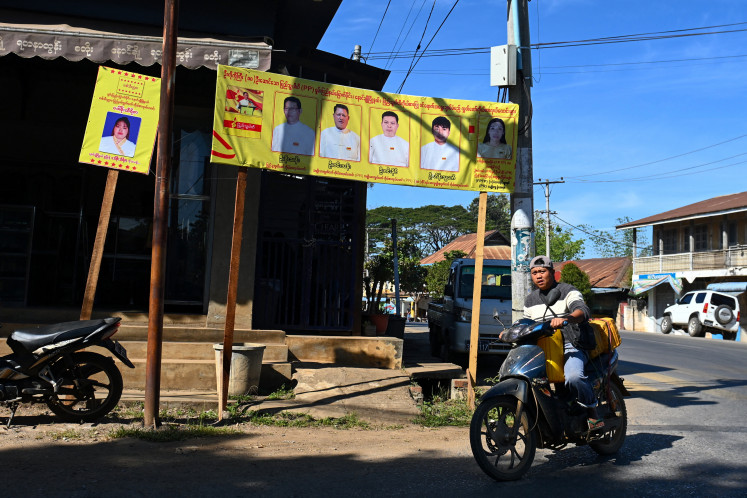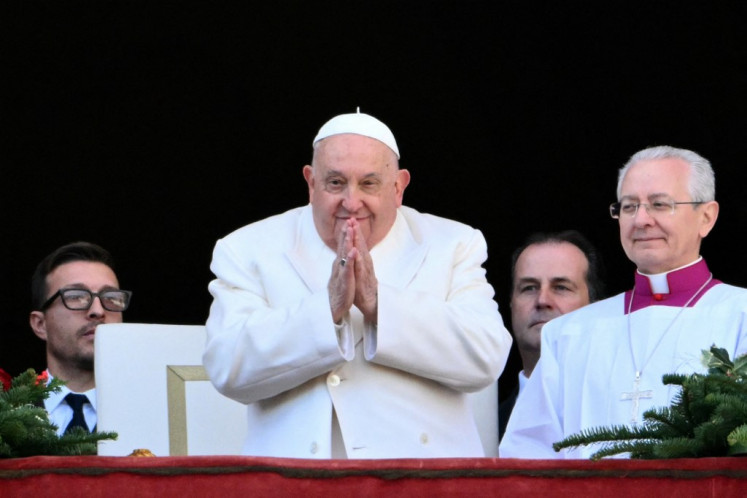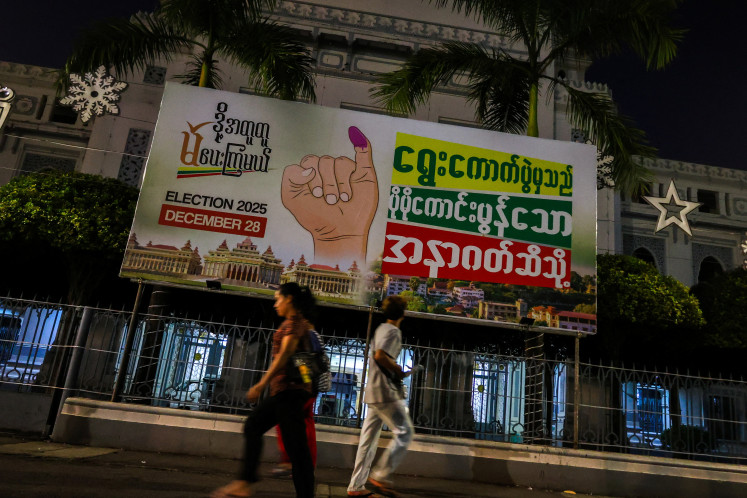Popular Reads
Top Results
Can't find what you're looking for?
View all search resultsPopular Reads
Top Results
Can't find what you're looking for?
View all search resultsWhy is soccer fandom so linked to violence?
What is it about soccer and its fan culture that makes such incidents more likely to occur?
Change text size
Gift Premium Articles
to Anyone
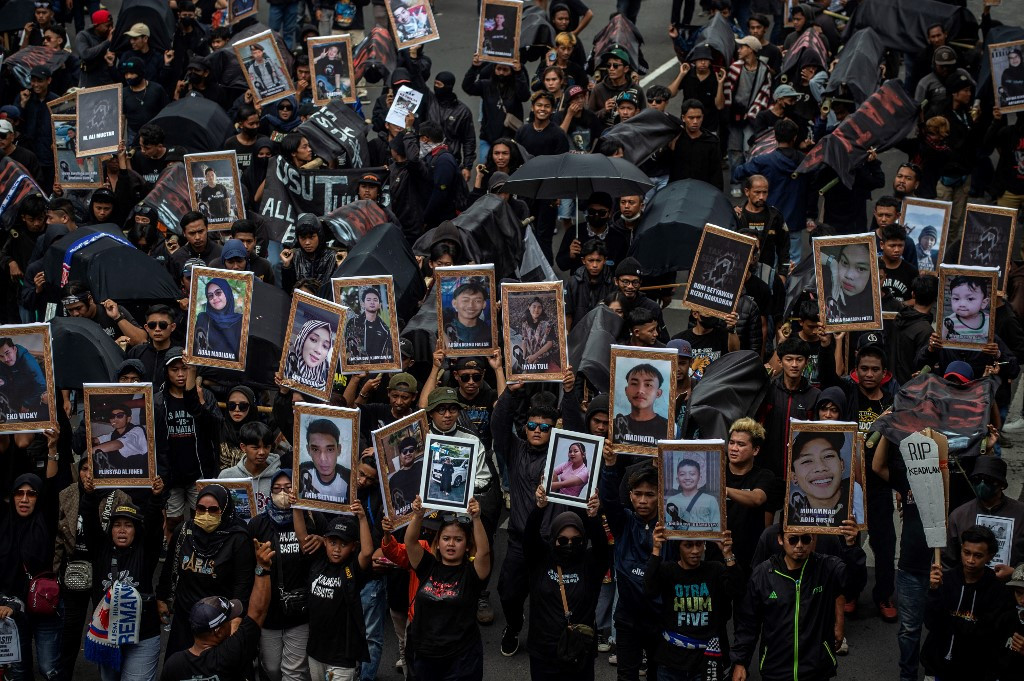 Lives lost: Fans attend a rally in front of City Hall in Malang, East Java, on Nov. 10, 2022, demanding that the Indonesian Football Association (PSSI) be responsible, fair, transparent and indiscriminate following the deadly stampede at Kanjuruhan Stadium on Oct. 1, which took 135 lives.
(AFP/Juni Kriswanto)
Lives lost: Fans attend a rally in front of City Hall in Malang, East Java, on Nov. 10, 2022, demanding that the Indonesian Football Association (PSSI) be responsible, fair, transparent and indiscriminate following the deadly stampede at Kanjuruhan Stadium on Oct. 1, which took 135 lives.
(AFP/Juni Kriswanto)
Soccer’s global allure is unmatched, yet its history is shadowed by tragedies.
At a recent soccer match in Nzérékoré, Guinea, a controversial refereeing decision led to unrest, resulting in crowd violence that claimed more than 50 lives.
In 2022, violence at East Java’s Kanjuruhan stadium during a match led to the deaths of 135 people, as security forces responded to pitch invasions with tear gas, triggering chaos and ultimately a crowd crush.
These incidents are stark reminders of the risks tied to violence in sports crowds. They stem from structural failures, poor crowd management and often complex group dynamics that lead to violent behavior.
Soccer crowds are especially prone to violence, which raises a pressing question: What is it about soccer and its fan culture that makes such incidents more likely to occur?
Catastrophic incidents rooted in fan violence have been intertwined with the history of this sport.
Perhaps the most extreme case is the Soccer War (more commonly known as the Football War) of 1969, when World Cup qualifiers between El Salvador and Honduras inflamed existing political tensions. Clashes between fans added to the animosity, and within days, the two nations were at war. More than 2,000 people died in the brief conflict.
There are other cases throughout the history of the game. In 1964 in Peru, the Estadio Nacional Disaster saw Riots break out after a disallowed goal during a Peru-Argentina match in Lima. Police used tear gas, causing chaos as fans tried to escape through locked exits. More than 300 people died.
After a match between Al-Masry and Al-Ahly at the Port Said Stadium in Egypt in 2012, fans attacked each other with weapons while exits were blocked. Seventy-four people died and hundreds were injured.
Soccer’s immense popularity means larger, more diverse fanbases with deeply ingrained rivalries.
Fans often see their team as a core part of their identity, with this strong group affiliation sometimes heightening “in-group versus out-group” dynamics. At times, this can lead to hostility.
And it’s not just fan-on-fan violence: Soccer fan violence takes many forms. Violent and antisocial acts range from verbal abuse and offensive chants to property damage, vandalism, pitch invasion and physical assaults.
In some countries, soccer fan violence has worsened since the pandemic.
In the United Kingdom, recent police statistics reveal a 59 percent increase in arrests compared to pre-pandemic levels, with incidents of disorder reaching an eight-year high. Notably, 70 percent of offenses were committed by people aged 18–30.
Players can be affected, too. A 2023 workplace safety report from the International Federation of Professional Footballers highlighted the escalating issue of violence against professional players, emphasizing its detrimental impact on their physical and mental wellbeing.
The report reveals a significant number of players have experienced abuse, including threats and physical assaults, both on and off the field. Data show fan violence against players is most common in Europe (particularly the UK, Italy and Germany) followed by Africa.
What’s behind the trend?
Soccer fan violence is often deeply tied to social identity dynamics.
Studies from Germany and Brazil emphasize the role of identity fusion, where fans experience an intense bond with their teams and fellow supporters.
This fusion creates a “warrior psychology”, making threats to the group feel personal, to the point that it can drive fans to defend their identity aggressively.
High-stakes rivalry games exacerbate this: Violence surges up to 70 percent during derby matches in Germany. These studies show that match-day violence is driven more by rivalry and group dynamics than game outcomes.
In Brazil, the same identity fusion has been shown to drive hostility, especially toward rival fan groups, as fans perceive out-group threats as existential.
Studies have also highlighted how “fanatic” supporters, often young, unemployed and with lower levels of education, are more likely to engage in violence, which is shaped by group norms and accepted aggression levels.
Studies in the UK have revealed historical shifts. While hooliganism once thrived in working-class and hyper-masculine cultures, better crowd management and gentrification have reduced in-stadium violence, though confrontations still occur away from arenas.
Furthermore, substance use can magnify aggression.
In the UK, cocaine use among fans is higher than the national average.
The combination of the growing fan drug culture in soccer with identity fusion can develop into aggressive behavior, particularly during intergroup conflicts.
Alcohol, while not universally causal, can also fuel confrontations by lowering inhibitions and amplifying territoriality.
Despite these patterns, some regions have seen significant improvements.
In the UK, decades of reforms, such as CCTV, all-seater stadiums and higher ticket prices have fostered a more “sanitized and gentrified” fan culture, with fans themselves often regulating violent behavior.
However, such measures can also displace violence to less-visible spaces, where rival groups arrange confrontations to avoid police detection.
Reducing soccer-related violence requires a multifaceted approach addressing both structural and psychological drivers. Evidence suggests creating positive group dynamics, rather than simply suppressing fan identity, is key.
Further strategies could also include initiatives to reframe rivalries as positive and reciprocal; better policing tactics using dialogue and de-escalation rather than force; improvements in managing crowd flows and reducing friction points, such as minimizing counterflows of rival fans during departures; and substance use interventions, particularly targeting drug use.
The challenge, however, lies in implementing these solutions while preserving the unique passion and energy that make soccer the world’s most beloved sport.
---
The writer is a senior lecturer of urban risk & resilience at UNSW Sydney. This article is republished under Creative Commons license.


